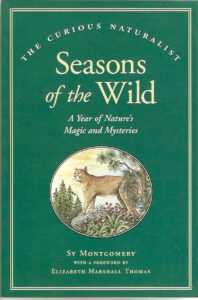Book Info

Genre: Nonfiction, Essays
Acquired from: Little Free Library, Ann Arbor, Michigan, USA [see visit log]
Started reading: August 6, 2025
Finished reading: tbd
Reading Updates
Page 0: This one didn’t come with a bookmark like Moby-Duck did, so I’m using one I got from Downtown Books in Milwaukee. I picked up this book partly because of the topic, partly because the blurbs on the back (“Sy Montgomery has insight into the Others that every nature writer on this continent envies.”), and partly because the author photos shows Sy holding a barred owl.
Page 7: (acknowledgments) wtf is a book lice
Page 11: (forward by author’s friend) Moby Dick mentioned!
Page 12: So basically the argument is that treating animals scientifically (using “it” instead of he/she, don’t anthropomorphize or assign human characteristics) has created a barrier between us (humans/natural world) and we have lost something as a result. Which could be true! But I also think that assigning human things to animals isn’t treating the animal as its own thing, but rather as an extension of humanity.
I should note this book was written in 1995. Anyway onto the actual book now
Page 20: These essays are short and (from this first one at least) mostly interesting facts about animals and how people view them. They’re also grouped by season, and the first one is autumn.
This first essay is about insects in September— mostly crickets— and there’s several things that made me go “wait what” and there’s no citations so I’m gonna have to do a lot of Wikipedia reading later. Like crickets make sounds by rubbing a wing against a hardened piece of other wing. Scientists apparently “reversed the wings” in a lab somewhere to see if the crickets could still make noise— but how did they reverse the wing? Also katydids are ”left winged” and field crickets are “right winged.” But why??
Page 23: Second essay is about bogs, which I don’t think I’ve visited yet or at least not deliberately so. Perhaps I’ll have to put that on my travel wishlist for next year.
Page 26: Third essay is about seeds and the stuff left behind once they get eaten or blown away etc which is a nice topic actually and not one most people think of! Usually we get rid of “dead” plants once the flowers die off. We even mow lawns so the grass doesn’t go to seed. But seeds (and seed pods) can be quite pretty!
Page 32: Fourth essay is about black bears, which I’ve never seen in person and don’t particularly want to see in the wild. I think they’re cute, but I don’t want to meet one.
Page 36: Fifth essay is about feeding wild birds by hand, which actually interests me greatly! (Especially in this particular backyard at this housesit in Ann Arbor, where there’s so many birds roaming around.) The key seems to be easing into it, to get the birds used to you being there over several weeks. Also to have things they desperately want to eat, ha!
Page 40: Sixth essay is about falls, the things that some insects do to trees and plants to grow babies. It’s gross to think about but much of nature is gross in some way.
Page 45: Seventh essay (and last of the autumn grouping) is about mountain lions, specifically ones that may be repopulating in New England. As it’s been 30 years since this book was written, it’d be interesting to see how things are nowadays…
Word List
- Tamarack
Book Wishlist
📚 Pods: Wildflowers and Weeds in Their Final Beauty by Jane Embertson, about floral arranging
📚 Swampwalker’s Journal by David Carroll, about bogs
See also: Books Read (2025) / All Reading Logs
